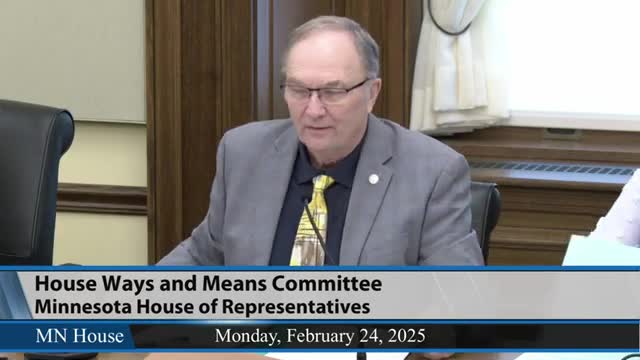House panel advances bill to track implementation of OLA recommendations
February 24, 2025 | 2025 Legislature MN, Minnesota
This article was created by AI summarizing key points discussed. AI makes mistakes, so for full details and context, please refer to the video of the full meeting. Please report any errors so we can fix them. Report an error »

The Minnesota House Ways and Means Committee on Feb. 24 voted to place House File 3, as amended, on the general register after a roll call that recorded 14 ayes and 13 noes.
House File 3, carried by Representative Paul Nash, would direct the Office of the Legislative Auditor (OLA) to repurpose prior program-evaluation and special-review findings into an accessible matrix that shows which recommendations have been implemented and which have not. The bill includes an A9 author’s amendment that the committee adopted before the roll-call vote.
The bill’s author, Representative Paul Nash, said the proposal would help limit future “fraud, waste and abuse” by giving committee chairs and ranking members a clear picture of whether past OLA recommendations were followed. “It will put the bill in the shape that I’d like,” Nash said when moving the amendment. Nash also told the committee the bill would give the Legislative Auditor the ability to follow up on prior recommendations rather than relying only on agency self-attestation.
Judy Randall, legislative auditor, described the matrix as a new format the office has piloted. “We did some follow-up work to the extent we could, with agencies to identify the extent to which our prior recommendations had been implemented,” Randall said. She explained that some recommendations are easy to verify with documents, while others—particularly programmatic changes—require file testing and additional resources to confirm implementation.
Several members raised concerns. Representative Cleburne said the office’s limited resources mean the matrix would not provide a complete inventory of all past audits and cautioned the public might misread an unimplemented recommendation as an agency deficiency even when the recommendation no longer applies. “That is a little concerning for me,” Cleburne said. Representative John Stevenson said the proposal would cost “about a half million dollars a biennium” and questioned whether that expenditure was the best use of funds during a tight budget cycle.
Nash defended the bill as a tool for oversight and for preventing future loss of public money. He said the fiscal note reflected the resources OLA said it would need to perform follow-up testing.
The committee adopted the A9 author’s amendment by voice vote earlier in the meeting; the committee then voted by roll call to place the amended bill on the general register.
The bill’s placement on the general register means it advances in the House process but is not final law. Any appropriation to finance OLA’s follow-up work or implementation of the matrix would require a separate legislative appropriation.
Votes at a glance: House File 3 (as amended) — placed on the general register; roll-call result: 14 ayes, 13 noes.
House File 3, carried by Representative Paul Nash, would direct the Office of the Legislative Auditor (OLA) to repurpose prior program-evaluation and special-review findings into an accessible matrix that shows which recommendations have been implemented and which have not. The bill includes an A9 author’s amendment that the committee adopted before the roll-call vote.
The bill’s author, Representative Paul Nash, said the proposal would help limit future “fraud, waste and abuse” by giving committee chairs and ranking members a clear picture of whether past OLA recommendations were followed. “It will put the bill in the shape that I’d like,” Nash said when moving the amendment. Nash also told the committee the bill would give the Legislative Auditor the ability to follow up on prior recommendations rather than relying only on agency self-attestation.
Judy Randall, legislative auditor, described the matrix as a new format the office has piloted. “We did some follow-up work to the extent we could, with agencies to identify the extent to which our prior recommendations had been implemented,” Randall said. She explained that some recommendations are easy to verify with documents, while others—particularly programmatic changes—require file testing and additional resources to confirm implementation.
Several members raised concerns. Representative Cleburne said the office’s limited resources mean the matrix would not provide a complete inventory of all past audits and cautioned the public might misread an unimplemented recommendation as an agency deficiency even when the recommendation no longer applies. “That is a little concerning for me,” Cleburne said. Representative John Stevenson said the proposal would cost “about a half million dollars a biennium” and questioned whether that expenditure was the best use of funds during a tight budget cycle.
Nash defended the bill as a tool for oversight and for preventing future loss of public money. He said the fiscal note reflected the resources OLA said it would need to perform follow-up testing.
The committee adopted the A9 author’s amendment by voice vote earlier in the meeting; the committee then voted by roll call to place the amended bill on the general register.
The bill’s placement on the general register means it advances in the House process but is not final law. Any appropriation to finance OLA’s follow-up work or implementation of the matrix would require a separate legislative appropriation.
Votes at a glance: House File 3 (as amended) — placed on the general register; roll-call result: 14 ayes, 13 noes.
View full meeting
This article is based on a recent meeting—watch the full video and explore the complete transcript for deeper insights into the discussion.
View full meeting
